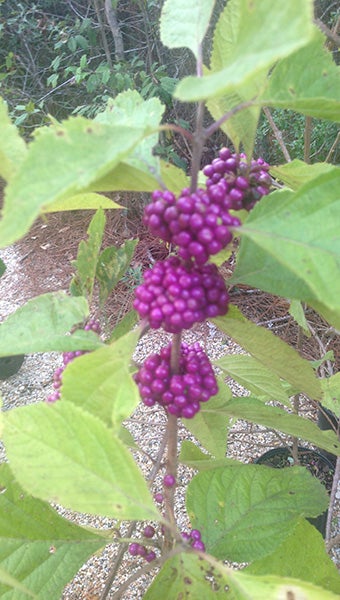Arboretum Paths: These native berries are plum beautiful
Published 7:00 am Wednesday, September 23, 2015

Plump clusters of fruit line the stems of a beautyberry bush at the Crosby Arboretum (photo by Pat Drackett).
During our Bugfest last weekend, we had the opportunity to walk the pathways and see which plants are putting on new blooms or developing fruit. To the delight of Brady Dunaway, one of our regular Bugfest volunteers, we encountered white American beautyberry (Callicarpa americana ‘Alba’) in fruit at our front entrance. The typical form of this native shrub, which has striking magenta-purple berries, is also fruiting at our service road gate.
Another common name for beautyberry is French Mulberry. The shrub is in the Verbena family and native to the southeastern United States. Although the arboretum features plants native to the Pearl River Drainage Basin, you will find an occasional native cultivar such as in this area outside our gate, or in our Children’s Garden.
Brady had a particular interest in this plant as he has, very impressively, been known to make beautyberry jelly from the fruit. This weekend, he pondered whether the white-berried form would also yield a palatable jelly.
To come across a native beautyberry shrub for the first time is an awesome sight. Also known as French mulberry, this is a large deciduous shrub that on average grows six to eight feet overall. Although it fades into your landscape most of the year, the berries which appear in late summer or early fall will make it a garden conversation piece.
Beautyberry shrubs have bright magenta-purple berries arranged in large ball-shaped clusters. These often weigh heavily on the stems, causing the branches to arch downward. Gardeners will be pleased to learn that beautyberry is very easily grown from cuttings. Small plants can often be found near mature specimens and transplanted to your garden bed.
Beautyberry flowers are inconspicuous. It’s the berries that steal the show. A number of cultivars are available, including a pink-berried form called ‘Welsh’s Pink’. At one time the arboretum offered a native Callicarpa with variegated leaves at our fall plant sales, and you will find that there are also attractive variegated non-native varieties available. Search the Web to find photos of the various selections.
Beautyberry berries are not palatable to humans, except in jelly, proving that sugar will improve the taste of anything. However, they are a food source for birds and animals such as fox and raccoons. New leaves are a favorite browse of white-tailed deer.
This is a great plant to locate in a naturalistic border along a property line or in a wildlife garden. Usually found growing in full or part-sun areas, I’ve on occasion seen Callicarpa doing just peachy in surprisingly shadier areas, for example under a live oak tree. Experiment with this shrub in your garden, as it is vigorous and adaptable. Great for beginners! It prefers well-drained soil, and is drought-tolerant.
Just make sure to give beautyberry ample room to spread. To have to constantly prune it is not only time-consuming for you, but constantly chopping away at its natural shape can turn it into an eyesore rather than a showstopper!
On Saturday, October 3, come enjoy an early morning 5K run through the Crosby Arboretum. Registration opens at 7 a.m. The run is organized by Teen Challenge of Poplarville and the registration fee is $25 ). Proceeds benefit this non-profit group. Pre-register online atwww.ACTIVE.com. For more information call (601) 795-8063 or contact Erica Sloan at tcofms.erica@hotmail.com.
Attend a “Fall Arrangements for Planters” workshop with senior curator Jill Mirkovich on September 26 from 10 to 11:30 a.m. Learn to create beautiful planted containers for the fall season using the season’s brightest annuals and perennials. Bring your own medium sized plant container. A limited selection of planters will also be available for purchase. Plants and potting soil provided. Members $10; non-members $15.
Take a fall wildflower field walk 1 to 2 p.m. on September 26. Tour the arboretum grounds with director Pat Drackett. Learn about the flora of our region and how to incorporate natives in your own garden. Free to members; $5 for non-members. Call 601-799-2311 to register for either program. Mark your calendar for the Arboretum’s Fall Plant Sale on Friday and Saturday, October 16 and 17.
The Arboretum is open Wednesdays through Sundays from 9 a.m. to 5 p.m. and located in Picayune, off I-59 Exit 4, at 370 Ridge Road (south of Walmart and adjacent to I-59).
By Patricia Drackett





